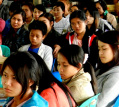The Salween Institute blends objective analysis and hands-on community empowerment programs to frame policy debate and help shape public policy in Burma/Myanmar based on social justice, environmental responsibilities and ethnic right to self-determination.
Analyses & Reports

Empowerment

Advisory Services

Support Us
|
Drawing Lessons from Sri Lankan ExperienceBy Saw Kholon
(Commentary) – Burma and Sri Lanka share religious and cultural heritages going back centuries. Diplomatic relations between the two countries have been maintained for more than 60 years. Sri Lanka had managed to defeat the ethnic insurgent group Liberation Tigers of Tamil Eelam (LTTE), popularly known as the Tamil Tigers, in May 2009, and through decisive military operations, it had brought the three-decade-old ethnic civil war to the end. In June 2009, just about one month after defeating the Tamil Tigers, Sri Lankan President Mahindra Rajapaksa paid an official visit to Burma to cement the two countries’ political tie, in addition to religious and cultural ties – the Theravada Buddhism, by reiterating the two countries’ bilateral commitment to enhance their military maneuvers. Burma was the first country to be visited by President Mahindra Rajapaksa after his government defeated the Tamil Tigers. In 2007, President Mahindra Rajapaksa also agreed to enhance intelligence sharing between the two countries and to intensify cooperation in combating terrorism. Speaking of terrorism, Burma is still riddled with the ethnic civil conflicts and the previous military regime of Burma often labeled ethnic resistance groups as terrorists. Observing this particular political movement between the two countries, it is unquestionable that Burma’s military leaders were impressed by Sri Lankan President Mahindra Rajapaksa’s unsympathetic military strategy used against the Tamil Tigers. And no doubt, one can easily see that Burma’s military leaders are interested in Sri Lankan model of counterinsurgency strategy and eager to learn more from President Mahindra Rajapaksa on how to defeat ethnic resistance forces. Norway’s role in Sri Lanka Peace process In 2000, Norway was invited by a joint venture between the Sri Lankan government headed by President Kumaratunga and the Tamil Tigers (Liberation Tigers of Tamil Eelam) to take the role of facilitator in the peace process. In 2002, a cease-fire agreement was established between the Sri Lankan government and the Tamil Tigers. In 2006, the cease-fire agreement was renewed by incoming President Mahindra Rajapaksa. However, in 2008, the Sri Lankan government headed by President Mahindra Rajapaksa axed the peace deal. The Sri Lankan Monitoring Mission (SLMM) with the majority of the officers from Norway had to leave the country. Subsequently, the Tamil Tigers were totally defeated by the Sri Lankan government in May 2009. Norway’s peace efforts in Sri Lanka from 1997 to 2009 produced nothing functional but the ephemeral cease-fire agreement with broader implications between the two warring parties. Norway’s role in the Sri Lankan peace process is by and large a failed undertaking on the subject of bringing an end to the civil war. The aspects contributing to the failure include that the Norwegian Peace Negotiators failed to understand the underlying realities of the country’s three-decade-old ethnic civil conflict. What is more, they understood the peace process as it was described in the paper. As a result, the peace process failed to bring Tamil's rights to self-determination. Moreover, it failed to induce fundamental changes in the nature of the two warring parties. However, the whole affect of the failed peace process was a successful mission in terms of bringing an end to the ethnic civil conflict with the ultimate defeat of the Tamil Tigers in May 2009. Norways’s role in Burmese politics Norway was the first Western government to send its development minister to meet with Burmese President Thein Sein. President Thein Sein wants to cooperate with Norway in the areas of hydroelectric power, oil and gas, and tourism as well as in the areas of health, education and the environment. Moreover, the Norwegian government announced that it would drop sanctions on Burma. Norwegian Foreign Minister Jonas Gahr Stoere said, “Many experiences show us that the ceasefire may not be the most difficult thing, but to make development work in an equitable and fair way and to have justice prevail, that is the complicated part.” The question is: Will Norway play the same role in Burma that it did in Sri Lanka? Lessons to be learned The Sri Lankan peace process mediated by Norway was merely a series of cease-fire agreements that lasted only for a short time. The peace process offered no durable political solution to the ethnic civil conflict. Instead, it led to more hostilities ending in the definitive extermination of the Tamil Tigers who fought against the Sri Lankan government for Tamil’s rights to self-determination. The Tamil Tigers fought for three decades for Tamil’s rights to self-determination only to be ruthlessly crushed by the Sri Lankan military forces at the end after going through a number of unproductive peace process. The story of how the destiny of the Tamil Tigers came to a halt after rounds of peace agreements with the Sri Lankan government should be looked at as a comparative example by the leaders of the Karen National Union as it moves forward with the peace process with the Burmese government. The KNU should be aware of the fact that Burma and Sri Lanka have diplomatic relations and agreed to share intelligence. The sincerity of President Thein Sein’s government over the ongoing peace negotiation process with ethnic resistance groups remains in doubt. The ongoing conflicts with the Kachin and the continued sending of military supplies into frontline territories in Karen State are just another instance of the insincerity of the Burmese government and the fragility of peace agreements. The Sri Lankan government did the same thing – sending military supplies to frontlines areas controlled by the Tamil Tigers while going through a series of peace agreements. Therefore, it is crucial that the KNU delegation emphasizes the withdrawal of the majority of the Burmese government forces from Karen State and the immediate halt of sending military supplies into frontlines areas in Karen State. Almost certainly, if fighting continues and increases, the Burmese government could follow the Sri Lankan government’s counterinsurgency model of, “Go to Hell.” Just as the Sri Lankan government ignored international criticism over its indiscriminate and ruthless crushing of the Tamil, the Burmese government could be expected to do the same. In fact, the continued fighting in Kacin State has already shown that the international community would not criticize the Burmese government to the extent that it would hurt its commercial interests, let alone take any concrete action against it. It is up to the KNU to avoid sharing the same fate of the Tamil Tigers. In the upcoming round of negotiations, the KNU delegation should continue to demand that the current negotiations and agreements go beyond a cease-fire stage. And it should continue to tell the international community that Burmese attempts to appease ethnic nationalities with economic incentives or resorting to decisive military means would only treat the symptoms of Burma’s ethnic unrest, not the root causes. Originally appared in the Mizzama News website. |

